Design Elements of Cable Membrane Architecture
Date:2015.3.24 Hit:3446
1.Expressive Characteristics of Cable Membrane Architectural Language
Since Frei Otto, a German architect regarded as the pioneer of cable-membrane architecture and structural technology, first successfully applied cable-membrane technology on a large scale in German Pavilion of Montreal Expo, Canada in 1967, several ups and downs have taken place in cable-membrane architecture today. Every ups and downs has made contemporary high-tech more widely involved and pushed cable-membrane construction technology to a new climax. The reason why cable-membrane buildings can be widely used today is that the development of high and new technology in recent years has a profound impact on society, environment, art and contemporary life. Nowadays, the respect for technology has become a fashion.
As we all know, Rogers and Piano's Pompidou Center design is the first time to show the so-called "high-tech" architecture of post-modernism to the world, and their outstanding practice in building technology performance and cable-membrane construction in recent years has achieved a high degree of harmony and unity between architecture and technology at a higher level. Of course, the so-called "high-tech school" in the past and today's "rational technological performance" are quite different. In the past, the "high-tech school" only regarded "technology" as a symbol, and used the "contrast contrast" formed by the rebellion against "modernism" to realize their new concepts and reflect their new architectural thinking. Today's "rational technological expression" is the basis of taking technological logic and technological means as the expression of architectural art. On this basis, the real technological logic is sublimated and refined, and the perfect combination of technology and art is pursued.
The "architectural language features" expressed by cable-membrane buildings show a clear tendency of "rational technical expression". The towering masts, special-shaped space steel structure system, the root cables of the beam, the large-scale steel joints with mechanical artistic charm, the changeable membrane body full of tension natural curve and other large-span free spaces which can not be reached by other technologies all give people artistic appeal and a certain degree of technological mystery, which makes cable-membrane architecture more expressive features emphasizing rational technological logic.
With the development of modern electronics, machinery and chemical technology, cable-membrane building is gradually developing. It is the embodiment of modern high-tech in the field of architecture. With the further development of modern science and technology, human beings are facing the mission of protecting the natural environment. Therefore, natural materials and traditional ancient building materials and technologies will be replaced by light, thin, high-strength and light-weight materials with good thermal insulation performance. Cable-membrane construction technology will play an important role in this change, and its wider application in the field of construction is foreseeable.
In recent years, the demand for cable-membrane construction technology in China's construction market has increased significantly. Many famous foreign cable-membrane technology companies have "landed" in China, such as Buro Happold and Landrell in the United Kingdom, Geiger and Birdair in the United States, Taiyo Kogyo in Japan and some professional cable-membrane manufacturers, the "landing" of these enterprises has led to the great development of cable-membrane construction in China, which has a bright future.
2. Classification of cable-membrane buildings
There are different opinions on the classification of cable-membrane buildings. In fact, it can be simply summarized as three types: tension, skeleton and inflatable.
2.1 Tension type: Tension type cable-membrane building is the essence and representative of cable-membrane building. Because of the plasticity of its architectural image and the high flexibility and adaptability of its structural mode, it is widely used. Some people divide the tension type into cable-net type, ridge-valley type and so on. The tensioned cable-membrane system is expressive and has strong structural performance, but its cost is slightly higher and its construction accuracy is also required.
2.2 skeleton type: skeleton type cable-membrane building is often used under certain specific conditions because of the limitations of its structural mode itself: skeleton system self-balancing, membrane is only an auxiliary, the strong structural role of membrane itself is insufficient, and so on. Some people call it secondary repetitive structure. The combination of skeleton and tension can often achieve more varied architectural effects. The skeleton cable-membrane system is implicit in architectural performance and has some limitations in structural performance. Its cost is lower than that of tension system.
2.3 Inflatable: Inflatable cable-membrane building has a long history, but its application area is narrow because of its obvious limitations in use function, such as single image, air-tight space requirements, etc. However, the aerated cable-membrane system has the advantages of low cost, fast construction speed and obvious advantages under specific conditions.
3. The Soul of Cable-Membrane Architecture-Pretension
The key point for cable-membrane building to meet the technical requirements of long-span free space is its effective space pre-tension system. Some people call cable-membrane building "pre-stressed soft shell". It is the pre-tension that makes the internal force of each part of the "soft shell" (cable and membrane) always greater than zero (always in tension state) under various most unfavorable loads, so that the "soft shell" becomes the structural media and building enclosure material for the overall work of space, and it is amphibious between the building and the structure. The key role of pre-tension in cable-membrane building is:
1) Make cable-membrane buildings full of charming tension curves and unpredictable space;
2) Make the whole spatial structure system work together;
3) Make the system cover large area, large span and no free space.
4) The system is able to withstand extreme adverse loads such as strong winds and heavy snow.
5) Make the membrane reduce wear and tear, prolong service life, and become a permanent building;
6) Make the cable-membrane buildings drain smoothly;
7) Make cable-membrane building a "roof accessible" and provide convenient conditions for overhaul.
It should be pointed out that the pre-tension is not a "installation measure" that can be adjusted at will in the construction process, but needs to be adjusted and determined repeatedly in the initial stage of design. It is the core and key that must be ensured in the whole process of design and construction. In this sense, the membrane covering without proper pre-tension measures carefully designed does not belong to the category of cable-membrane buildings.
4. Basic Elements of Cable Membrane Architecture Scheme Design
4.1 Environment: Architectural design pays more and more attention to the environment, and whether the relationship with the overall environment is harmonious has become the key to judge the success of architectural design. Cable-membrane buildings are highly flexible in space and plane layout, which often integrate with the surrounding environment very naturally. Consciously using the free form of cable-membrane architecture to form a multi-level transformation of space convergence and separation is the basic accomplishment that professional cable-membrane architects should possess.
4.2 Contrast and Coordination: Like general architectural design, "Contrast and Coordination" is also the "housekeeping treasure" of cable-membrane architects. Unlike general architectural design, the use of contrastive techniques may be more. Because in the city, a large number of architectural images are in the change of rectangular sequence, but the technical performance image of cable-membrane buildings is different. It is not decorated and concise and beautiful dynamic appearance, if used skillfully, it can play a "finishing touch" and "refreshing and refreshing" effect. Coordination technique is also one of the commonly used treatment techniques in cable-membrane buildings. It is often better to set off each other and play a supporting role so that the overall effect can reach a new height.
4.3 Application of "Super-scale": Because of the structural and technical characteristics of cable-membrane buildings themselves, they often present super-scale architectural performance. It is a common method in the design of cable-membrane buildings to achieve a higher level of scale coordination by means of super-scale comparison.
4.4 Application of color and night scene effect: Because PVDF (polyvinylidene fluoride film surface coating) and PTEE (polytetrafluoroethylene film surface coating) do not properly solve the problem of color addition, at present the film is mainly white.
The Night Scene Effect of cable-membrane building is colourful, with obvious "building identifiability" and commercial effect. The translucency of the film itself and the application of color floodlighting are the key to the effect of night scenery.
5. Combination of Architecture and Structure in Cable Membrane Architectural Design
The contradiction between architecture and structure in general architectural design has become a perfect combination in the design of cable-membrane buildings. In essence, the cable-membrane construction scheme must also be the cable-membrane structure system scheme. The scheme starts from the preliminary consideration of the cable-membrane structure. The cable-membrane architect must have a deep understanding of the cable-membrane structure system and understand its working principle. In the design of cable-membrane buildings, comprehensive consideration must be given to:
1) Whether the force of the system is uniform (the preliminary shaping test can be carried out by the design software);
2) Whether the system can be properly controlled by pre-tension (preliminary calculation and test with design software);
3) Whether the setting position and mode of the prestressing mechanism are reasonably selected can smoothly transfer the prestressing force to all directions, ensure the normal operation of the prestressing mechanism and meet the visual and functional requirements (determined by repeated consultation with structural engineers based on experience);
4) Can we avoid excessive thrust or tension to make the structure unbearable (using design software to make preliminary calculation and find out the location where the most adverse reaction occurs)?
5) Can the points of the system be prevented from excessive displacement under the most unfavorable loads and even affect the normal use of the building?
6) Whether the position and size of each foundation and anchor seat meet the requirements of visual aesthetics and functional use, and special attention should be paid to the fact that each anchor point does not affect pedestrian or vehicle traffic;
7) Whether it can ensure reasonable and smooth drainage and reasonable choice of non-organized drainage or organized drainage. The drainage gradient of cable-membrane buildings is higher than that of ordinary buildings (which can be judged by design software or experience).
8) The layout and orientation of the weld seam of the membrane material are comprehensively considered from the aspects of structural stress, processing and visual effect.
9) Consider the influence of the location of key joints and the location of pre-tension mechanism on the overall effect of the building.
10) Consider the construction method of cable-membrane boundary and its influence on the overall effect of the building.
11) Guarantee the reasonable and effective waterproof construction measures of each joint.
12) Proper consideration should be given to reasonable thermal insulation measures, effective natural ventilation and exhaust should be organized to minimize energy consumption.
From the above points, it can be clearly seen that the process of cable-membrane architecture design is actually inseparable from the cable-membrane structure design and technical design. The development of cable-membrane architecture requires a large number of professional architects who are familiar with cable-membrane architecture design, understand cable-membrane structure technology and can skillfully use it for architectural creation. If the cable-membrane construction project can only rely on cable-membrane structural engineers or manufacturers to complete the cable-membrane construction business, it will become "craftsmen workshop" of "bad goods", and its vigorous life potential will be annihilated. At present, the architect of non-cable-membrane architecture should try to know more about cable-membrane architecture and structure technology when designing cable-membrane architecture scheme. If the conditions are not available, it is better to contact the professional staff of cable-membrane structure as soon as possible during the scheme period, so as to avoid passivity.
-
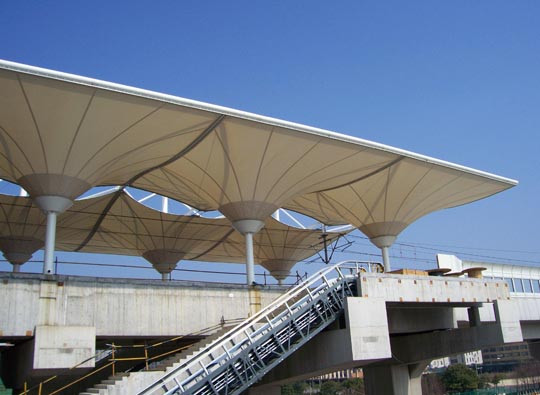 Application of Membrane Structure in Rail Transit...
Application of Membrane Structure in Rail Transit... -
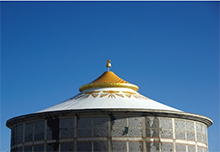 Application of Thermal Insulation Lining Technology in Membrane Archit...
Application of Thermal Insulation Lining Technology in Membrane Archit... -
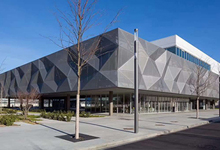 Application of membrane curtain wall...
Application of membrane curtain wall... -
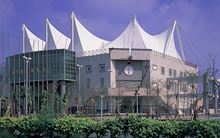 Application of Membrane Roofing...
Application of Membrane Roofing... -
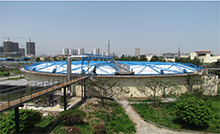 Application of Membrane Structure in Environmental Protection Engineer...
Application of Membrane Structure in Environmental Protection Engineer... -
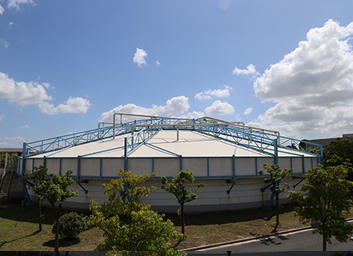 Application of Membrane Structure in Sewage Treatment Plant...
Application of Membrane Structure in Sewage Treatment Plant...

